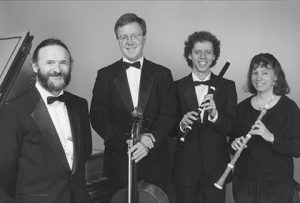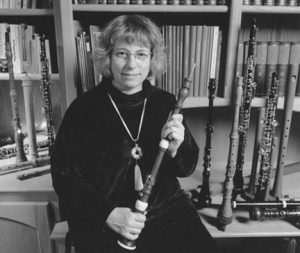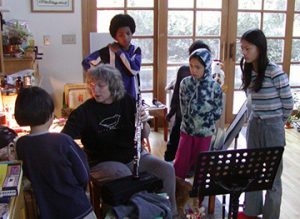 by Alex Walsh
by Alex Walsh
Carol Panofsky is an oboist, pianist, teacher, contractor, graphic artist, and former board member of Local 346 (Santa Cruz). A Bay Area native, Carol was born in Oakland, grew up in Los Altos, and currently lives in Santa Cruz where she happily makes music and feeds the birds on her back patio.
Carol Panofsky began playing the oboe when she was 10. She actually started with the flute, but had to return it at the end of fifth grade because there was a waiting list. When Carol asked, “What am I going to do now?” Her teacher pointed to an instrument in the corner and said she could have it for as long as she was in the district. “It was an oboe. No one else was interested so I took it. I really liked it because it wasn’t as competitive as the flute.”
As a toddler, Carol was told that she would often sit at the family piano and make noise. “When I was a little older I had grandiose fantasies about playing for large audiences. I don’t know where that came from since I don’t remember being taken to concerts at that age.” Her parents soon gave her piano lessons.
Carol says her mother was not musically inclined, but later in life she found out that her father had a nice singing voice. Carol’s father was a Professor of Physics at Stanford University. His family fled Germany in the 1930s and settled in Princeton, NJ. He met her mother while doing graduate work at CalTech. In the early 1960s, he was the director of the Stanford Linear Accelerator Center (SLAC). As a young man, he had witnessed the first test of the atomic bomb and later dedicated his life to promoting nuclear disarmament.
When Carol brought home the oboe her family was not encouraging. “There were five children, and I was pretty far down the ladder. Outside the family, I got a fair amount of attention and support even though I wasn’t very good.” She was inspired to play and continued all through high school in the orchestra. She was also a member of the El Camino Youth Symphony. As a junior, she spent a year in Italy in public school and brought her oboe. By this time she realized that she had to make music or she would go crazy. “If I didn’t play I would get depressed and eat too much. I didn’t know what to do with myself.”

Santa Cruz Chamber Players, 1987
Back row: Robert Fenwick, Bill Mathews, unidentified singer, Debra Spencer, Andy Connell, unidentified bassoonist, Mary Badarak Middle row: Carol Panofsky
Front row: Luciana Lombardi, Gene Lewis, Mary Jane Cope
After high school, Carol went to UC Santa Cruz. She played in the school orchestra and the Santa Cruz County Symphony, but left in frustration because back then it wasn’t as good as the university orchestra. “I returned when they hired Maestro George Barati and they started paying their musicians. It had started like a regular community orchestra where you rehearse every week for a very long time and the results were poor. When they unionized we started getting better players. We had fewer rehearsals but they were more intense because people knew they actually had to learn their music before they went into rehearsal. That was a big change.”
Carol joined Local 346 in Santa Cruz and began gigging in the South Bay; Santa Cruz, Salinas, Carmel, Watsonville and Monterey, as well as Palo Alto. Considered one of the top players, her professors assumed she would go on to Julliard. ’Don’t you want to be principal oboe in the SF Symphony?’ they would ask her. They were surprised when she said no. “At age 20 I knew I didn’t want that. I loved playing in the orchestra, having solos and working with other players. But I just couldn’t imagine it being a ‘job’ where it was the same repertoire with the same people every day. To call it ‘work’ didn’t feel creative.”
During this time Carol became fascinated with early music. “I got to college and started to think about orchestration and composition and the fact that composers wrote their music with a certain sound in their heads, therefore playing transcriptions never did justice to the music. If you played violin solos on the oboe you were never going to get to the place that the composer wanted. I realized I needed to play on the instruments they wrote the music for. I became pretty zealous about that idea. I then realized playing baroque music on modern instruments was just as inadequate.”
Carol decided to go to the New England Conservatory to study performance practice and early music. She started playing Baroque oboe primarily, as well as recorder, sackbut and shawm. When Carol returned to teach at UC Santa Cruz she found that everything had changed. Her orchestra chair was filled and her grand ideas about playing early music did not materialize. At the same time, Carol discovered the gamelan, which was taught at UCSC. “Being a sucker for odd and weird instruments, I plunged into the gamelan with the same enthusiasm I had for oboe. When the teacher had to go back to Indonesia for a semester I would substitute, so I was also teaching it.”

Albany Consort, 1995
Johnathan Salzedo, harpsichord and Director, Joel Schaefer, Baroque cello, Lars Johannessohn, Baroque flute, Carol Panofsky, Baroque oboe
By 1980, Carol was working hard to re-establish herself on the freelance scene. She joined the Santa Cruz Chamber Players, a cooperative that played concerts in the public library, and Albany Consort, an early music group. During this time, she met and married her husband, Stanley Williamson.
Carol’s modern oboe career was tragically cut short due to health issues. “I had trouble staying pregnant. The doctor finally decided that it was the oboe playing that was causing me to lose the babies, because the more oboe I played the quicker I lost them. For one of those pregnancies I had just finished dress rehearsals. During the two-hour break before the concert I went into labor. I’m sitting there in the car thinking, ‘How am I supposed to go play?’ But I did. Afterwards I told them not to expect me tomorrow for the second performance. No one knew I was pregnant or what I was experiencing and I didn’t tell anyone. They did find someone to play my part, but I was in the hospital and there was nothing I could do about it. There was a span where nobody could trust me because of my ‘health issues’. And for seven years I was afraid to accept jobs. It was very difficult. Then in 1988, my son was born.”
WILL YOU JOIN THE BOARD?
In the mid-80s, Carol became a contractor, mainly for weddings and the Santa Cruz Chorale. In 1989, she got a call from the president of the Santa Cruz Local. “I thought I was in trouble because I had contracted an orchestra and a couple musicians weren’t in the union. I got a call from Red Malone asking me to please show up at this meeting and I thought, ‘Oh no. I’m going to be castigated!’ I came in on my best behavior and he said, ‘Will you join the board?’”
“It was interesting to see what they were all worried about. They had been working on a directory for years and they just couldn’t finish because as soon as they made progress everything would change. It was a huge thing in their minds, this directory. They did finally manage to publish it. It was on file cards so it was a huge project.”
Serving on the board was an education for Carol. “In board meetings, they were very concerned to make sure you put in the contract that the band gets to eat, which was not relevant in the circles I traveled in. This changed the way I contracted weddings. I started putting in the contract that the band was going to eat, even though we were playing recorders.”
“I remember one of the big controversies at the time was there was a shopping mall that wanted an orchestra to play in the center of the mall. When they found out what it was going to cost they went to the youth symphony and got some kids to play for nothing. It was very upsetting to the Union.”

Carol in 2004:“The Baroque oboe is such a lovely sound. It’s the right tool for the job if that’s the music you’re playing. Baroque oboe doesn’t have the stamina issues that a modern oboe does. When you play Bach arias on modern oboe you get tired, but on Baroque oboe you don’t. It has a bigger bore and doesn’t fight back. It squeaks and plays out of tune, is unhappy in keys with lots of accidentals, and has a cranky high register. It’s very hard to play Baroque and modern oboe side by side. But they help each other, one has made me a better player on the other because of the unique challenges.”
During this time Carol was heavily involved with the Santa Cruz Chamber Players. What started as a cooperative playing in the Santa Cruz library had developed to the point where Carol decided to learn computers so she could provide them with nice programs and posters. “We packed the place and got to the point where many of the players had gotten professional enough where they wanted real venues and real audiences, so SC Players got their non-profit status. Today they have season tickets and ad sales and grant writing and all of that. We do 6 concerts a year. Each one with a different music director. I direct a concert for them about once every other year, as well as do their graphics.”
During the nineties and 2000s Carol continued to play early music, contract orchestras and weddings, develop her desktop publishing business, and teach. She became passionate about music literacy and developed a music theory curriculum for children which makes it fun to learn. Today Carol serves as Theory Director for the Ragazzi Boys Chorus, about 200 kids. Her job is to teach them to read music. “How many adults have you met that say, ‘Oh, I used to play the piano (flute, violin…), but I hated the theory!’ That is very common, and it breaks my heart. So the big thing is not only to teach theory so that they actually learn and understand, but also to do it in a way that is enjoyable. I got frustrated with available theory methods and wrote my own. By now, probably 1000 kids have gone through the program, so it has been tested and rewritten as necessary!”
Five years ago, Carol was hospitalized with pneumonia. When she was released she found she couldn’t make a sound on any wind instrument. When she complained to her doctor he told her to play the piano. “I said, ‘But I don’t play the piano.’ So, I got a piano teacher and now I practice 2, 3, 4, 6, 10 hours a day. I’m getting somewhere and it’s wonderful. And I can now play the oboe again.”
In 2007 Carol started a concert series, Munching With Mozart, because she was angry. She saw how difficult it was for musicians to find venues, and how expensive it could be for audiences to experience live music. She wanted to bridge that gulf so she went back to providing music at the Santa Cruz public library.
“Most creative things in life happen because you’re angry. I just thought, ‘This isn’t working for me. Playing music for people needs to be easier. It’s so hard to get the concerts set up and to get the people to come.’ Then I thought, ‘Well, Santa Cruz Chamber Players started in the library, so let’s go back to the library.’”
Munching with Mozart is now celebrating its 10th anniversary. Carol performs often in the series, on both oboe and piano. “I make a nice program for the audience and kids get to come. People bring their lunches.”
UNION YES!

Interacting with the next generation, giving an oboe demo with “Nancy’s Kids” in her home studio, 2005
Though Carol does not play as many union gigs as she used to, she continues to be a proud AFM member.
“I think the union is making a huge difference on the ability to travel with instruments, and the ivory issue. One of my instruments has antique ivory on it. I’m going to the UK to gig in December—but that oboe is not going with me, unfortunately.”
“My son plays the cello. There was one flight where they didn’t want to let him fly because he had an end pin—as if he was going to kill somebody with his endpin! I know that the union is working very, very hard on these issues. When I get notifications from the union my answer is always, ‘Yes!!!”
